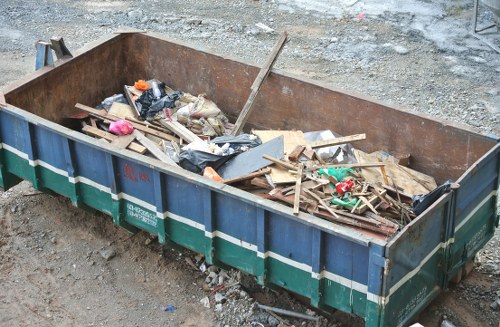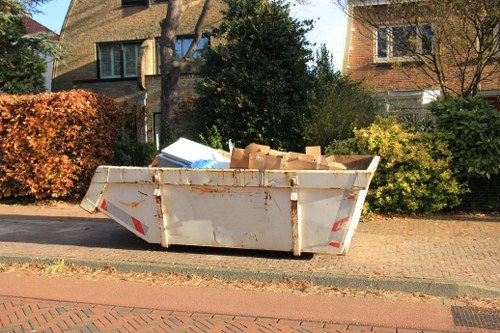Construction Waste Disposal in Willesden

Construction projects generate a significant amount of waste, making effective waste disposal crucial. In Willesden, managing construction waste not only ensures compliance with local regulations but also contributes to environmental sustainability.
Proper disposal of construction waste involves several steps, including sorting, recycling, and choosing the right disposal methods. It is essential for contractors and homeowners alike to understand the best practices to minimize their environmental footprint.
Failure to manage construction waste properly can lead to legal penalties, increased costs, and negative environmental impacts. Therefore, it is imperative to adopt efficient waste management strategies from the outset of any construction project.

Importance of Proper Waste Management in Construction
Effective waste management in construction plays a pivotal role in promoting sustainability. By reducing the amount of waste sent to landfills, we can minimize the environmental impact and conserve natural resources.
Moreover, proper waste disposal ensures compliance with local and national regulations, avoiding potential fines and legal issues. It also enhances the reputation of construction businesses by demonstrating their commitment to environmental stewardship.
In addition to environmental and legal benefits, efficient waste management can lead to cost savings. Recycling materials can reduce the need for new resources, and streamlined waste disposal processes can improve overall project efficiency.

Environmental Impact
Construction waste contributes significantly to pollution and resource depletion. Materials such as concrete, wood, and metal, when not disposed of correctly, can harm ecosystems and wildlife.
By implementing sustainable waste management practices, construction projects can reduce their carbon footprint. This includes recycling materials, reusing components, and minimizing the use of non-renewable resources.
Additionally, proper waste disposal helps in reducing greenhouse gas emissions by decreasing the reliance on landfills, which are major sources of methane, a potent greenhouse gas.
Legal Requirements
Willesden has specific regulations governing construction waste disposal. It is essential to be aware of these laws to ensure that all waste is handled in compliance with local standards.
Non-compliance can result in hefty fines and project delays. Therefore, partnering with a professional waste disposal service that is knowledgeable about local regulations is highly recommended.
Understanding and adhering to these legal requirements not only avoids penalties but also promotes ethical business practices within the construction industry.
Local Regulations in Willesden
Willesden enforces strict guidelines on how construction waste should be managed. These regulations mandate the segregation of different waste types, proper labeling, and approved disposal methods.
Contractors must obtain necessary permits and ensure that waste is transported to authorized facilities. Regular audits and inspections are conducted to monitor compliance.
Staying updated with the latest regulatory changes is crucial for maintaining compliance and avoiding legal complications.

Methods of Construction Waste Disposal
There are several methods available for disposing of construction waste in Willesden. Each method has its advantages and is suitable for different types of waste.
Choosing the right disposal method depends on factors such as the nature of the waste, volume, and the specific requirements of the project.
Understanding these methods helps in making informed decisions that are both environmentally responsible and cost-effective.
Recycling and Reuse
Recycling is one of the most sustainable methods of waste disposal. Materials like metal, concrete, wood, and drywall can be processed and reused in other construction projects.
Recycling not only reduces the need for new raw materials but also lowers the overall cost of construction by making use of existing resources.
Implementing a robust recycling program can significantly decrease the environmental impact of construction activities.
Landfill Disposal
Landfill disposal is a common method for non-recyclable construction waste. However, it should be considered a last resort due to its environmental implications.
Landfills take up valuable land space and can lead to soil and water contamination if not managed properly.
It's important to minimize the amount of waste sent to landfills by prioritizing recycling and reuse wherever possible.
Incineration
Incineration involves burning waste at high temperatures, reducing its volume and sometimes generating energy in the process.
While incineration can be effective for certain types of waste, it may release pollutants into the atmosphere, making it less environmentally friendly compared to recycling.
Careful consideration and adherence to environmental standards are necessary when opting for incineration as a waste disposal method.

Choosing the Right Waste Disposal Service in Willesden
Selecting a dependable waste disposal service is crucial for efficient construction waste management. The right service provider ensures that waste is handled responsibly and in compliance with all regulations.
Factors to consider when choosing a service include their experience, range of services, pricing, and reputation within the community.
Partnering with a local provider can offer additional benefits such as prompt service and a better understanding of local regulations.
Factors to Consider
- Experience and expertise in construction waste disposal
- Range of services offered, including recycling and special waste handling
- Compliance with local and national regulations
- Competitive pricing and transparent billing
- Customer reviews and testimonials
Top Providers in the Area
- EcoWaste Solutions
- Green Disposal Wilkes
- Willesden Waste Management
Service Offerings
Top providers typically offer a comprehensive range of services, including waste collection, sorting, recycling, and disposal.
Some may also provide on-site waste management consultations to help optimize your waste disposal strategy.
Choosing a provider with a broad service offering ensures that all your waste disposal needs are met efficiently.
Benefits of Professional Waste Disposal
Engaging a professional waste disposal service offers numerous advantages for construction projects in Willesden.
These benefits include cost savings, improved efficiency, and ensuring compliance with all relevant regulations.
Professional services bring expertise and resources that may not be available in-house, leading to a more streamlined waste management process.
Cost-Effectiveness
While there is an upfront cost associated with hiring a professional service, the long-term savings are significant.
Professionals can help reduce the overall waste disposal costs through efficient sorting and recycling practices.
Additionally, avoiding fines related to non-compliance can result in substantial financial savings.
Efficiency and Time-Saving
Outsourcing waste disposal allows construction teams to focus on their core activities without getting bogged down by waste management tasks.
Professional services have the necessary equipment and expertise to handle waste quickly and efficiently.
This leads to faster project completion times and increased productivity.
Compliance and Peace of Mind
Professional waste disposal services ensure that all waste is handled in accordance with local regulations, providing peace of mind.
This helps avoid legal issues and maintains the project's reputation for adhering to environmental standards.
Knowing that waste is managed responsibly allows teams to concentrate on delivering high-quality construction work.
Steps to Effective Waste Disposal
Implementing an effective waste disposal plan involves several key steps. Each step is essential for ensuring that waste is managed responsibly and efficiently.
Following a structured approach can help in minimizing waste generation and optimizing disposal processes.
Here are the primary steps to effective construction waste disposal:
Waste Sorting
Sorting waste at the source separates recyclable materials from non-recyclable ones, facilitating easier disposal and recycling.
Implementing a sorting system on-site ensures that materials are categorized correctly, reducing the volume of waste sent to landfills.
Proper sorting is the first step towards sustainable waste management in construction.
Transportation
Efficiently transporting waste to disposal sites is crucial for timely project completion.
Choosing reliable transportation services ensures that waste is moved safely and without delays.
Proper transportation methods prevent environmental contamination and comply with disposal regulations.
Processing and Disposal
Once at the disposal site, waste needs to be processed appropriately.
This includes further sorting, recycling, or preparing waste for landfill or incineration.
Effective processing ensures that waste is handled responsibly, minimizing environmental impact.
Tips for Reducing Construction Waste
Reducing construction waste is not only environmentally beneficial but also contributes to cost savings and project efficiency.
Implementing proactive strategies can significantly decrease the amount of waste generated during construction.
Here are some effective tips for reducing construction waste:
Planning and Design
- Optimize designs to minimize excess material usage
- Use precise measurements to reduce offcuts and scraps
- Incorporate modular construction techniques
Material Selection
- Choose sustainable and recyclable materials
- Opt for materials with minimal packaging
- Use high-quality materials to reduce the need for replacements
On-site Management
- Implement strict waste segregation protocols
- Train staff on waste reduction practices
- Monitor and track waste generation regularly
Adopting Sustainable Practices
By integrating sustainable practices into the construction process, waste can be significantly reduced.
This includes adopting green building standards, using energy-efficient machinery, and promoting a culture of sustainability among the workforce.
Sustainable practices not only reduce waste but also enhance the overall quality and efficiency of construction projects.
Future of Construction Waste Disposal in Willesden
The future of construction waste disposal in Willesden is moving towards more sustainable and technologically advanced methods.
Innovations in waste management are driving the industry towards reduced environmental impact and increased efficiency.
Staying abreast of these developments is essential for businesses to remain competitive and compliant.
Sustainable Practices
There is a growing emphasis on sustainable waste management practices, such as zero-waste construction and circular economy models.
These approaches aim to eliminate waste through the reuse and recycling of materials, promoting long-term sustainability.
Adopting sustainable practices ensures that construction waste disposal aligns with global environmental goals.
Technological Innovations
Advancements in technology are revolutionizing construction waste disposal. Innovations like automated sorting systems, waste-to-energy solutions, and digital waste tracking are becoming more prevalent.
These technologies enhance the efficiency and effectiveness of waste management processes, reducing human error and increasing recycling rates.
Investing in technological solutions can lead to significant improvements in waste disposal practices.
Embracing Change
As the construction industry evolves, embracing new waste disposal methods and technologies is crucial for sustainability and efficiency.
Businesses that proactively adopt these changes will benefit from cost savings, improved reputation, and a smaller environmental footprint.
The future of construction waste disposal in Willesden is bright, with opportunities for innovation and sustainable growth.
Contact Us Today
Managing construction waste efficiently is essential for the success of any project in Willesden. Don’t let waste disposal overwhelm your construction plans.
Reach out to our professional waste disposal services to ensure your project adheres to all regulations and sustainability standards.
Book your service now and take the first step towards a greener, more efficient construction process.